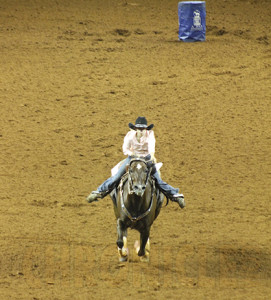Conditioning Your Horse For Gaming Events
 Michigan State University Extension by: Katie Ockert
Michigan State University Extension by: Katie Ockert
Gaming events such as barrel racing, pole bending, flag races and the like are very popular among youth riders. These events require the horse to exude speed, agility, proper form, sharp turns, and fast lead changes, and just like any human athlete, the horse must be in proper condition, or fitness level, to achieve success and avoid injury. Michigan State University Extension recommends the following ways you can prepare your horse for the late spring and summer shows.
First, riders must assess the level of conditioning their horse is currently in. If he has been loafing in the pasture all winter eating from a round bale, he may take longer to condition than a horse that has been ridden during the winter months. Assess your horse’s muscle tone – is he lacking muscle anywhere? The hind quarter, shoulders and topline are the areas where most horses will visibly lose muscle tone. Is he fairly equally muscled on both sides of his body? This can be a little tricky to determine, but once you begin riding, you will likely notice a difference in ability to perform exercises between the right side and the left side of the horse.
Second, because the horse depends on its feet and legs, make sure the horse is up-to-date on farrier work. If you generally have your horse shod when you compete, make sure to schedule your farrier appointment before you begin conditioning your horse. Soundness issues often stem from feet and leg issues; it may also be prudent to have your veterinarian perform a soundness exam to make sure there are no soft tissue injuries.
After you have made sure your horse is sound and ready for work, begin with short conditioning sessions at the walk and trot only and mostly in straight lines and soft curves or serpentines for 20 to 30 minutes per day. This will allow your horse to build up his muscles slowly while allowing all of the horse’s muscles, tendons and ligaments to stretch. Asking a horse that is not conditioned properly to perform small, tight turns will put undue stress on under-developed muscles, tendons and ligaments and could cause injury.
During your short conditioning sessions, make sure to monitor your horse. How fast does he get sweaty? Does he lack stamina? Is he struggling with anything in particular? While at the trot, make sure to ask your horse for an extended or long trot for a portion of the time, meaning that the horse is extending his legs and covering more ground. Start slowly and add time as your horse becomes better conditioned.
 If your horse becomes bored with flat work, you can add in items like ground poles or cones or barrels to serpentine around. Both of these tools will help your horse build his topline when he is working the drills with collection.
If your horse becomes bored with flat work, you can add in items like ground poles or cones or barrels to serpentine around. Both of these tools will help your horse build his topline when he is working the drills with collection.
After your horse has been worked at the walk, trot and long trot, and has properly developed his muscle tone, you may begin loping to enhance his lung capacity. Start with large circles in both directions and progress to smaller, sharper circles that mimic the turns he will perform during gaming events.
Always monitor your horse; pushing your horse too hard and too fast will only increase chance of injury. Take your time with spring conditioning to help insure your horse is ready for summer shows.
This article was published by Michigan State University Extension. For more information, visit http://www.msue.msu.edu. To have a digest of information delivered straight to your email inbox, visit http://www.msue.msu.edu/newsletters. To contact an expert in your area, visit http://expert.msue.msu.edu, or call 888-MSUE4MI (888-678-3464).










